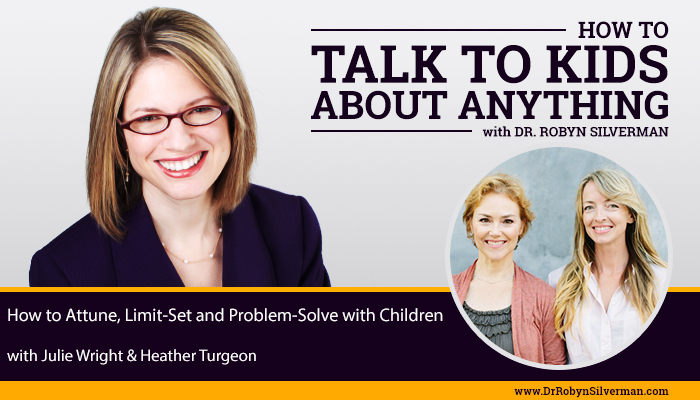Podcast: Play in new window | Download
Subscribe: Apple Podcasts | RSS | More
How to Attune, Set Limits and Problem-Solve with Children in Difficult Moments
This podcast will focus on the ALP system, developed by Heather Turgeon and Julie Wright. We will discuss how to “Attune” so our children know we understand what the frustration is, “Limit-Set” so our children understand what they can and can’t do and “Problem-Solve” so they know the options of what is appropriate and can take action in a positive way. The three-step-system allows parents to rely on a helpful tool in frustrating situations when we may otherwise fall into a habit of reacting harshly or giving-in to our children’s behavior just to get through the day.
Perhaps you’ve made the mistake of cutting your child’s sandwich into triangles instead of squares. Or you’ve dealt with siblings  that won’t stop fighting, a child who refuses to get out of bed or cries when you try to leave the house. And perhaps your child’s struggles, tantrums, refusals, frustrations have gotten a little bit under your skin and made you hot under the collar— and while you tell yourself to be patient and loving, you start yelling, threatening, bribing or caving under the pressure. We get it. SO many parents feel helpless, desperate and frustrated when their kids just won’t cooperate or seem so unreasonable and you are just trying to get out of the house, get them to bed or get dinner on the table. My guests today will give us what to do and say in these moments using their ALP system that they’ve taught thousands of parents in their clinical practice over the years.
that won’t stop fighting, a child who refuses to get out of bed or cries when you try to leave the house. And perhaps your child’s struggles, tantrums, refusals, frustrations have gotten a little bit under your skin and made you hot under the collar— and while you tell yourself to be patient and loving, you start yelling, threatening, bribing or caving under the pressure. We get it. SO many parents feel helpless, desperate and frustrated when their kids just won’t cooperate or seem so unreasonable and you are just trying to get out of the house, get them to bed or get dinner on the table. My guests today will give us what to do and say in these moments using their ALP system that they’ve taught thousands of parents in their clinical practice over the years.
Heather Turgeon MFT and Julie Wright MFT are the authors of the new book Now Say This: The right words to solve every parenting dilemma (Penguin RandomHouse), as well as the popular sleep book, The Happy Sleeper. Based in NYC and Los Angeles, they frequently speak and offer consultations to families on communication, setting limits with empathy, sleep, and more. Follow them on Instagram and Facebook @TheHappySleeper
The podcast provides:
- What the ALP system is and how it works
- Signs that feelings are being obscured or pushed down
- Automatic vs attuned responses
- Examples of how to use the ALP system in specific situations
- How to attune with your kids
- Why we need limits and how to empty them
- How to involve your children in problem-solving
- Favorite tools to calm the household
Important Messages:
- During typical frustrating issues, many people will harshly react or they will cave. ALP helps.

- ALP stands for Attune, Limit set and Problem Solve
- In the heat of the moment, we need to know what to say. Three steps help us to be warm, set a limit and problem solve.
- The tip of the iceberg— acting out behaviors- they are acting out their feelings in ways that are not appropriate. Temper tantrums, bad moods, not cooperative. But what are they happening?
- Once you attune, you’ll need to move to the limit-setting.
- Limits are important for safety, politeness, kindness.
- Limits give kids more time to learn, do and play. It must be consistent- if not, kids waste a lot of time trying to find out where the limit is.
- If we don’t take time to attune to our child and notice them— especially when they are trying to get our attention or approval, they will keep doing the behavior until you acknowledge it— they want you to see it!
- In the limit step, we say the limit and then we briefly say why. For example, “in our family, we don’t hit because hitting hurts people.” That way it doesn’t seem like just dictating rules.
- We’ve relied on rewards and punishments for so long. This doesn’t really work.
- Punishments can make kids hide their real feelings, lie and really angry. They aren’t really learning.
- We want our kids to be creative problem-solvers- not follow rules just because we say so. Think outside box. Supported by studies.
- Problem-solving is the most fun step. Creative. Solve dilemma and fulfill intention in a way that’s appropriate. You told them you understand what they want or don’t want, you told them what they can or can not do and now you’re going to help them get what they want in a way that’s appropriate.
- How much do you help them problem solve? Depends on age and ability- but the goal is to take yourself out of the picture because they will be adults one day. Scaffolding. Even when they are younger they can feel helpful.
- Problem-solving can be out of the box thinking.
- The problem solving can show that you understand, that you are going to hold the limit— but you can use a little humor, creativity.
- Attuning- show a joining and commiserating.
- Problem-solving. It’s hard to do transitions. Something that makes them want to do it. Snacks? Be close to parents?
- Different to help them realize that “when you do this, we’ll be able to do that” from “if you do this, you’ll get that.” Subtle but different. Getting work done and then you can do what you’d like. Related.
- PrepStep- work you do before ALP. Checking in- what’s best before the situation.
- Sportscaster tool- narrate what you see in front of you. Describe what’s going on but don’t take sides. “I hear that you are having a feeling- what’s going on?” Limit- we don’t kick.” Problem-solving. Do you need to take a moment with me to sit away in another room?”
- Child who wants a snack right before dinner: “It’s okay to be hungry. Food tastes so much better when you’re hungry! And we are leaving space in our bellies for dinner.”
- The good waiter: repeats and makes sure you heard them. Part of the attune step. You can get down at their level so they can really see your face and you can let them know you understand.
- Sportscaster- tool adopted by the kids. “I hear Mary saying _____, so can you repeat that back to her so she knows you hear her and understand?” Listening skill. Practice with kids when young.
Notable Quotables:
 “The magic sauce of ALP is that it encompasses everything. You start by attuning, you lead into limit-setting and you end with problem-solving.” ~Heather Turgeon
“The magic sauce of ALP is that it encompasses everything. You start by attuning, you lead into limit-setting and you end with problem-solving.” ~Heather Turgeon- “We need to look beneath the surface of the iceberg to see what’s really going on.” ~Julie Wright
- “The ultimate goal is to have our children tell us how they feel and not act it out.” ~JW
- “When we attune, we need to pause and really take our children in- you are joining with how they are really feeling in that moment. Kneel down. Take a good look. It’s a connecting moment and they feel felt in that moment.” ~JW
- “Limit-setting does just that, it limits the world in a way that children feel that they can handle it and makes them less anxious. The world is too vast to be too open-ended and for them to have free reign. They know where the limit it is— it’s not unkind, it’s kind because the children feel safe.” ~JW
- If we are not consistent with limits, children spend a lot of time trying to find out where the limits are. And that’s a waste of time. ~JW
- “Take 10 seconds to attune to your child and your limit-setting will be so much more successful.” ~HT
- “When you set a limit, briefly say why. When you do that, children start to operate from a place of principle than just following a rule.” ~JW
- “If you are just paying attention to what’s visible- the tip of the iceberg- and you’re rewarding or punishing behaviors that are outwardly obvious, you’re missing 90% of your child because all of the real stuff is under the surface.” ~HT
- “Punishments and rewards shut down creativity and we really want creative problem-solving in our homes.” ~HT
- “When dealing with frustrating situations, remember, time is your friend. Take a moment, take a deep breath. Always give yourself a moment to center yourself before you hav a knee-jerk reaction. Come up with a reaction that’s chosen rather than automatic.” ~JW









